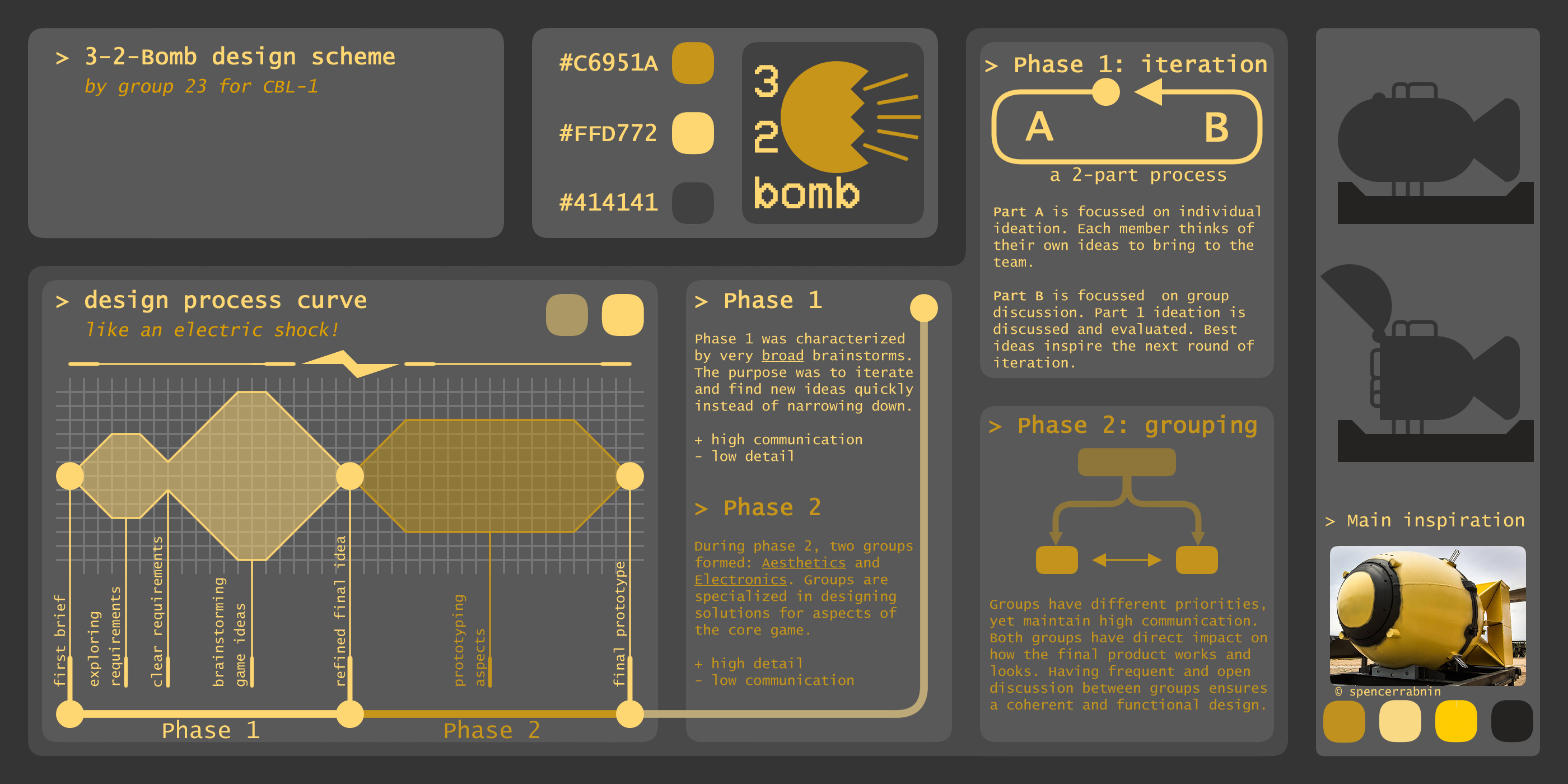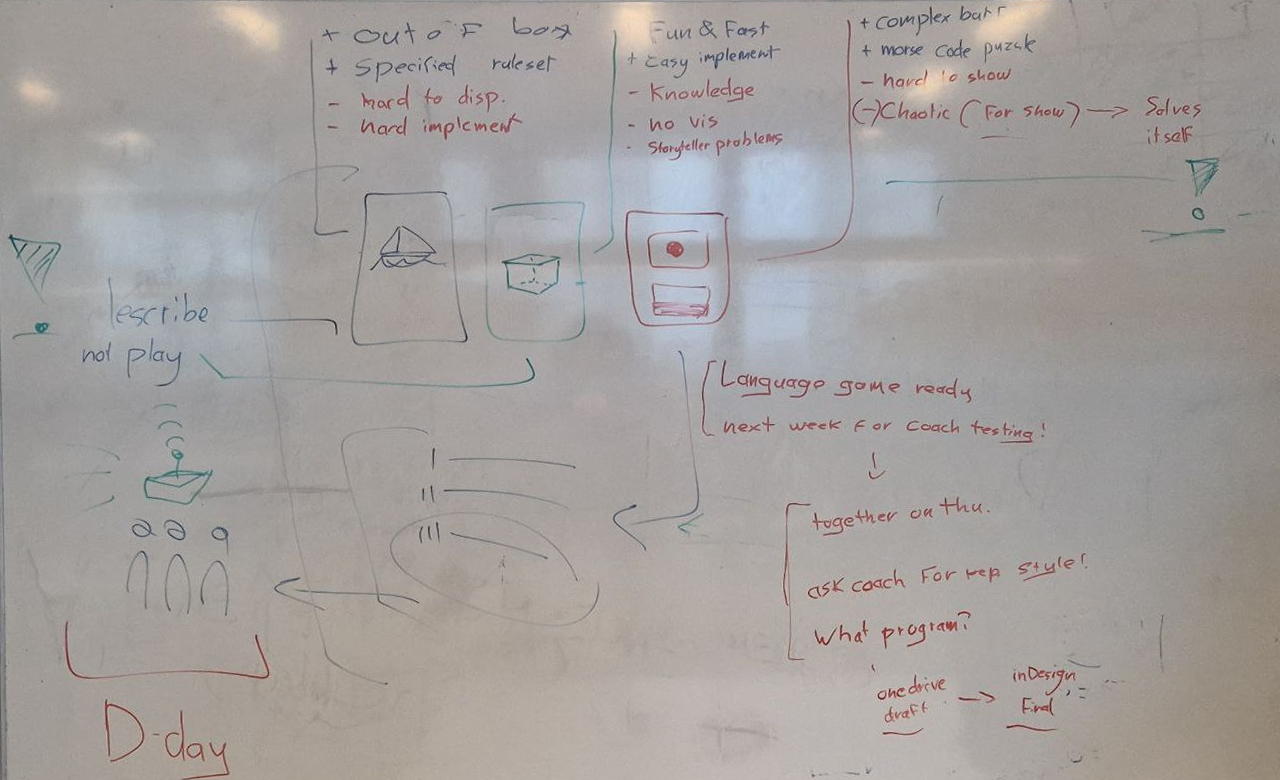CBL-1 Personal Reflection
Introduction - Project as a Whole
CBL-1 (P1) has been a broad project with a lot of learning opportunities, both personal and team-related. There have been tough moments, like one of our team-members not being available most of the time due to personal circumstances or the report having to be handed in half-made in InDesign because only 3 people were fully focused on getting things handed in. But there were also motivating and inspiring moments. Getting things done and seeing our finished prototypes work has been a very satisfying and relieving moment for all. This document is a compilation of my own perspective and learning moments in this project.
From Idea to Prototype - Group Design Process
P1 was a large and complex project with very little limitations. This allowed us to be quite versatile in terms of what direction we wanted our design process to take, and how it fits within the Reflective Transformative Design Process (RTDP). Important for me was noticing what strengths our team had in each quadrant of this process. I consider myself to be quite strong in Doing/Making. And I have plenty of skills doing research within an academic framework from my previous major of Chemical Engineering, this contributes to the Analyzing/Abstracting part of the RTDP. This project served as a good learning opportunity for me to test out my making skills in practice, and refresh my academic writing. The project also allowed me to explore ideation from the Envisioning/Transforming quadrant, which I still consider something I want to put emphasis on during next projects, as I tend to narrow down and choose ideas fast before exploring more. I made sure to join the extra class discussing this area.
Looking at the project as a whole, I have been the person to identify and draw out a lot of the design process and lead the team through it.

Image above is a design scheme drawn by me illustrating the project as a whole.
What I want to focus on especially is the split between phase 1 and phase 2, and the key moments in the project characterized by additional notes in the graph. Our general process was a derivative of the Double-Diamond process, but we managed to alter it to address the dynamics in our own group. Phase 2, named grouping, was mainly my orchestration. We split into two cells characterized by their own leanings in expertise areas, which will be touched on later. This splitting was done based on a buddy-system so members of our group got the potential to learn new skills, which was a key part to our project.
Team Dynamics - Role and Achievements
Ever since the beginning of the project, I have taken a leader role within our group as evident by the previous chapter. I made it my goal to set a good example for my team members and always be able to discuss and talk about things regarding what needs to be done. I wanted to put emphasis on being motivated and inspiring. This has succeeded. During the first week of the project I managed to assemble the team, and have a preliminary meeting scheduled in order to get to know each other. Following this, I made sure to discuss what everyone's strengths and weaknesses are, and what they wish to learn during the project. This sets precedent. Ever since the start of the project I have maintained my role as leader, and all important design decisions have first been discussed under my guidance. I got heavily inspired by the polder model, which is a method to come to a decision despite differences in opinion. I implemented this by making sure everyone was content with decisions made in the design, and gave the go-ahead to continue. If this wasn't the case, I made sure to come with a compromise and explain why another option could be better. No shortcut was made and nobody's opinion in the team went unheard. This is crucial to the polder model. An example of an implementation is a meeting we had in December where we discussed what themes we would work out for user testing and the final prototype to be included in the report. All themes were laid out on the board after having done a preliminary heuristic evaluation during the same meeting. We used the plus-minus-interesting method to determine positive and negative characteristics for each theme. At every point, everyone had a say in what happens.

The image above shows the whiteboard of the meeting, as drawn by me.
The drawing also showcases another key aspect: I tend to work in a visual style to better convey my message and intentions. If I speak, I will almost always have a notebook or whiteboard to scribble on. This helps keep a paper trail of what has been discussed, but also helps team members better understand me and each other in discussions by being able to see the insights contextualized beyond words.
A picture is worth a thousand words.
There have also been parts which could see an improvement. The polder model, whilst very effective, also takes up a lot of time. This means a lot of time was discussing nuances instead of working out said concept and moving through the process faster. The coaches have been content with the progress made on a weekly basis, though more emphasis should be put on good documentation practice, which was lacking at the start of the project, but eventually figured out during the part in Q2. Nonetheless, I would like to work on communicating and documenting more effectively, perhaps taking the whiteboard scribbling to another level by creating high quality sketches or fieldnote-style notes in my documentation.
Expertise in Action - C&A and U&S
Creativity & Aesthetics (CA), and User & Society (US) have been big supports for me in the project, especially in phase 2 of the project. In my own perspective of this project, CA not only includes visual aesthetics, but also how users perceive the experience of the game as a whole (aesthetics of interaction), which ties into US. US in our project has been mostly about how our game functions and engages the user. On a broader scale it includes the context of our game and who our users are, which was explored with personas. I made sure to split the team into two groups each leaning more on a different expertise area, these are the areas of CA and US. I have been present as a team leader between both groups to maintain balance and integrity, but personally I was more responsible for the aesthetics of the project. Layout, coherence and design language for all the projects has been my responsibility. An interesting point is coherence, which is something that to me has been the key in both expertise areas and something I see in more refined and mature projects (balance and integrity). Our coach Carlijn also made sure to give some valuable feedback on this during the project which I made sure to implement this by setting standards for our project, as seen in the above design scheme. Fonts, colors, and branding have been high quality and consistent over the entire project, as well as a consistency in design such as rounded edges and materials. To me this is an important aspect which connects both CA and US for a refined UX. It also ties to my aspirations as a designer beyond this project, I want to make high quality and refined objects which make sense in our highly integrated world.
Moving forward - Lessons learned from P1
This project has been a very good first trial for me as a student of Industrial Design. It has been a valuable and educational experience to move through the entire design process for the first time. I discovered that I am quite skilled at leading a team, even despite some unfortunate circumstances. I also got to push my sketching skills even more through the classes of Martijn and apply them in our project. Something I'm most proud of in terms of personal achievements is the coherence of the entire design mentioned previously. Something I want to work on would be bettering my communication, furthering my own sketching and documentation skills which have shone through especially in the second part of the project. All in all, these skills have furthered me in terms of personal aspirations as a designer, and also made me more aware of how connected US and CA are through the scope of making high quality and refined designs, which has always fascinated me, and I can now more confidently implement in future projects.